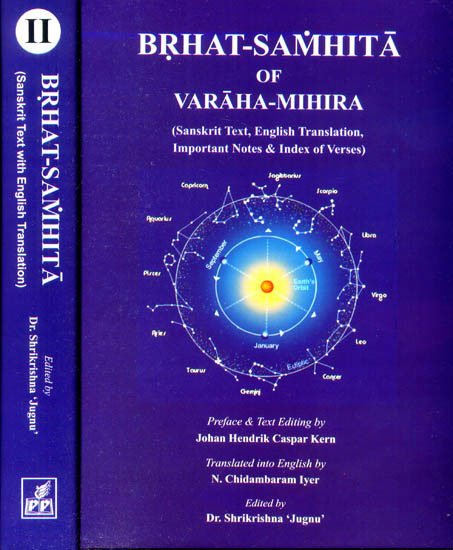Brihat Samhita
by N. Chidambaram Iyer | 1884 | 135,584 words | ISBN-13: 9788171104215
This page describes gems (ratna-pariksha) which is the eightieth Chapter of the English translation of the Brihat-samhita. This work, written by Varahamihira in the 6th century, is classified as jyotisha literature, also known as Indian astronomy. It contains however, also content regarding astrology, palmistry, agriculture, gardening, perfumes, medicines and various other encyclopedic topics.
Chapter 80 - On Gems (ratna-parīkṣā)
[Sanskrit text for this chapter is available]
1. A good gem (ratna) brings prosperity to the king and a bad one brings misery. It is therefore necessary to examine the properties of gems with the help of persons learned in the science; for a person’s fortune depends upon the gems he possesses.
2. Elephants, horses and women possessed of excellent virtues are also known as gems; but diamonds and the like gems (ratna) to be treated of in this chapter are stones and the like possessed of many excellent qualities.
3. According to some, gems are the bones of Balāsura and according to others, they are the bones of the sage Dadhīci. In the opinion of some, gems are various sorts of stones which naturally exist in the earth.
4. Twenty-two different sorts of gems (ratna) are mentioned. These are—Diamond, Sapphire, Emerald, Agate, Ruby, Blood-stone, Beryl, Amethyst, Vimalaka, Quartz, Crystal, Moon-stone, Saugandhika, Opal, Conch-shell, Azure-stone, Topaz, Brahmamaṇi, Jyotīrasa, Sasyaka, Pearl and Coral.
6. Diamonds found on the banks of the river Veṇa are white; those found in the province of Audh are somewhat yellow; diamonds found in Saurāṣṭra are somewhat of the colour of copper and those of Saurpāra are black.
7. The Himālayan diamonds are somewhat of the colour of copper and those found in the Mataṇga mountains are somewhat yellow. Diamonds of Kaliṅga are yellowish and Pauṇḍra diamonds are black.
8. A diamond which is white and has six sides is sacred to Indra; one that is black and of the shape of the mouth of the serpent is sacred to Yama; one that is green and of various shapes is sacred to Viṣṇu.
9. A diamond which is of the shape of a female’s genital organ and of the colour of the flower of Karṇikāra (Pterospermum acerifolium) is sacred to Varuṇa; one that is of the shape of the fruit of Śṛṅgāṭaka (Trapa bispinosa) and of the colour of the eyes of the tiger is sacred to Agni.
10. A diamond which is of the shape of a grain of barley and of the colour of the flower of the Aśoka is sacred to Vāyu.[1] Diamonds are generally found in rivers, lakes, deep or marshy places.
11. The Kṣatriyas shall wear red or yellow diamonds; the Brāhmaṇas shall wear white diamonds; the Vaiśyas shall wear diamonds which are slighty yellow and the Śūdras shall wear those which are black.
12-13. Eight mustard seeds (white) make a Taṇḍula. The price of a diamond weighing 20 Taṇḍulas is 200, 000 Kārṣāpaṇas;[2] and the price of diamonds weighing two Taṇḍulas less and less are respectively three-fourths, two-thirds, one-half, one-third, one-fifth, one-sixteenth, one twenty-fifth, one-hundredth and one-thousandth parts of 200,000 Kārṣāpaṇas.
[Notes—The following table shows the price of diamonds:—
Weight in Taṇḍulas Price in Kārṣāpaṇas Weight in Taṇḍulas Price in Kārṣāpaṇas 20 200,000 10 40,000 18 150,000 8 12,500 16 133,333 6 8,000 14 100,000 4 2,000 12 66,666 2 200 For intermediate weight, the price shall be determined by proportion.]
14. A superior diamond is one which cannot be broken with any other substance, which is light and dazzling, which is of the colour of lightning, fire or rainbow and which floats in water. It always brings prosperity,,
15. The faults of the diamond are—lines of the shape of the foot of the crow, a fly or a hare or being mixed with other minerals, or covered with holes like gravel, being with split ends, appearing soiled or with dark spots and being of unsteady light or split or broken. Such diamonds are not fit for use.
16. Diamonds with bubbles or split ends or flat and long shall be priced one-eighth less than the price assigned.
17. Persons learned in the science say that a woman desirous of sons shall wear diamonds. According to some, diamonds are not to be worn at all; diamonds of the shape of the fruit of Śṛṅgāṭa, of the pulse, of the coriander seed, and of the hip-bone shall be worn by women desirous of sons.
18. A person wearing bad diamonds, will lose his people, wealth and life. Good diamonds worn by kings will free them from the attacks of lightning, poison and enemies, and will bring great prosperity.
Footnotes and references:
[1]:
The mantras sacred to particular Devas shall first be pronounced and the diamonds shall then be worn.
[2]:
A Kārṣāpaṇa is 20 Rs. as it obtains among merchants, it is a gold coin whose weight is 16 māṣas equal to one-fourth pala.
